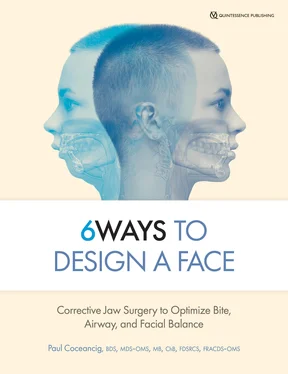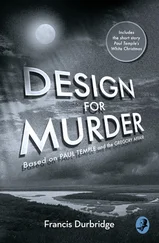The blank look, slight facial twitch, and total quiet of the orthodontist spoke everything in his mind about that horrible suggestion. His considered reply, confident and calm and practiced, was to explain that my mandible was too big, and when I was old enough I could have it broken surgically to bring it backward. He commented that this operation was horrible and full of risks; it sounded dreadful. It was obvious that extracting some premolars was the infinitely lesser of two evils. He said it would give me a perfect smile. He had dental models that explained the logic of it all. A lateral cephalometric radiograph explained his mathematics. He gave examples. He gave prices. He was a highly regarded dental specialist.
My father wanted another opinion, but my mother wanted to go ahead. In the end they said it was my decision, and my 13-year-old brain certainly didn’t want my jaw broken, and I certainly didn’t like my underbite or the look of my impacted canine, and I certainly didn’t want to look like my flat-faced aunty either. So I decided it was best to remove my premolars. Two visits, two needles, and two teeth on each side. They put them in a jar for me to take home. My mother cried.
My orthodontic appliances were placed a month later, and when they were eventually taken off 2 years later when I was 15, it was not the pretty smile result my parents or I had expected. Even my schoolteachers expressed dismay at the cosmetic result. Four on the floor, braces in 24. All my school friends had had it too. We all had the same straight-teeth, flat-face look. And so too did every other school kid on the Sydney train network. One treatment fitted all. The famous Sydney smile was everywhere. I hadn’t escaped my aunty’s fate.
The orthodontic retainer was very hard to wear. My teeth moved; they became crooked again. The positive overbite the orthodontist had struggled to gain by pulling my mandibular anterior teeth backward and maxillary anterior teeth forward gradually, relentlessly became edge-to-edge. Eventually I had a reverse bite again. My troublesome canine popped out of alignment. I saw my orthodontist every 6 months for follow-up, and every time he just told me to keep wearing my retainer. It was unbearable.
When I finished school and started university, I started experiencing jaw pain. After fabricating my own bite splint, which turned out to be useless, I visited my orthodontist, telling him that I was now a dental student. Essentially I was asking him as a mentor now to help me put all the random problems together, to help me fix them, to fix me. He smiled, said he was proud of me, said I must be stressed from all the study, and promptly referred me to an oral surgeon down the street to have my third molars removed.
When I turned up, the oral surgeon simply filled out a Sydney Hospital booking form. When I asked why I had to get my third molars removed, he told me that my parents had paid for braces and the orthodontist had asked, and of course because of the tooth crowding that came from not wearing my retainer. He wasn’t interested in my jaw pain, saying it would clear up after the third molars were removed anyway. The fact that he was too busy and important to look at me for all the 5 minutes I was in his office made me start to doubt these people. All of them. The dentists who taught me. The dentists who treated me. The science that surrounded everything to do with how faces and bites developed and how they developed together. No one ever really explained anything to me, either as a patient or as a dental student. It was all a complete and illogical mystery to me. Why did everyone need braces for crowded teeth? Why did every kid I know have to have their premolars and third molars removed? Why did everyone need their tonsils out? Why did everyone have allergies, asthma, stress, and jaw pain? Here I was surrounded by books and people and institutions that should have been able to explain it all logically and coherently and scientifically, but they didn’t. I kept wondering how I could have all of these unrelatable separate diseases affecting me? It was like one diagnosis per doctor. Damn was I unlucky.
I decided not to get my third molars removed, and they erupted normally (and I still have them). My jaw pain resolved by simply not chewing anything, my nasal allergies cleared up when I moved out of my parent’s home and into a series of new student houses, and coincidentally I discovered a love for lap swimming, which also saw my allergic rhinitis, atopic eczema, and chronic asthma all miraculously clear up. It seemed all I had to do was escape Macquarie Street and my mum’s insistence on the perfection of a Macquarie Street medical mind.
MY SECOND ORTHODONTIC EXPERIENCE
After moving to New Zealand and talking with many surgeons about what jaw surgery really was, I was still too afraid of it for myself. There was just so little known about it, and the jaw surgeons I worked with in training were mostly operating on syndromal kids and car accident victims. Besides, pushing my mandible backward simply to get a better bite seemed the opposite of what I needed, and my surgical mentors agreed. I was convinced it would surely choke me too, wouldn’t it? No one seemed to agree with me on the potential breathing issues, but nonetheless I thought it was my maxilla that needed to be brought forward, which supported my mother’s original, though very radical suggestion some 12 years previously. In the meantime I had orthodontic appliances put back on to see if I could achieve at least a stable bite and a smile I could live with.
In 1995 my new orthodontist was adamant that the science and predictability of maxillary surgery was still a long way off. The SARME (surgically assisted rapid maxillary expansion) operation was just getting a foothold in the United States, Professor Maurice Mommaerts in Belgium was still 5 years away from developing his bone-borne palatal expansion device, jaw distraction technology was just starting (and badly), routine jaw correction surgery was just beginning a radical renaissance via Bill Arnett in the United States, and custom titanium plates for midfacial surgery wouldn’t be developed in France for another 20 years.
My new orthodontist was convinced he could “grow” my small maxilla with a slower treatment cycle and edgewise brackets. I decided to believe him, and I endured another 2 years of orthodontic appliances, which didn’t manage to grow anything of course. Silly me. I still had a flat midface, a too-big mandible, and a weird smile. And I snored. But I did have straight front teeth in a barely normal positive overbite.
SELF-REFLECTION AND FRUSTRATION
What this repeat orthodontic experience did for me was point out that I could not explain my own face to myself. I could not form a rational argument with an orthodontist. I could not see how all of my component layers and the interrelated parts fitted together three dimensionally. I could not see how my teeth sat in my dental bone, or how the dental bone sat in my jawbones, or how my jawbones sat in my face. I could hardly dissect myself. I could not see where my symmetry or proportionality or bite issues began or ended. And if I couldn’t see them or simply describe them, how could I direct myself to seek the treatment that I needed or understand or critically examine the orthodontic advice I was receiving? And how could I seek to describe anyone’s bite or jaw problems or aim to surgically treat what was evidentially a complex interrelational set of anatomical issues involving many medical and dental and cosmetic themes?
In the 1980s and 1990s there was very little known about how anyone could dynamically see inside a person. There were radiographs of course, but these produced flat 2D views. What I wanted to know was how to construct a whole face, how teeth sat three dimensionally in the pattern of the midface, and how that related to all the structures inside it and outside of it.
Читать дальше












